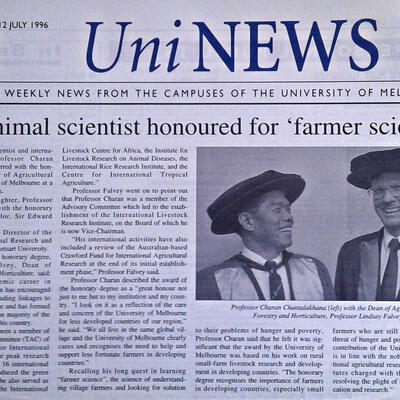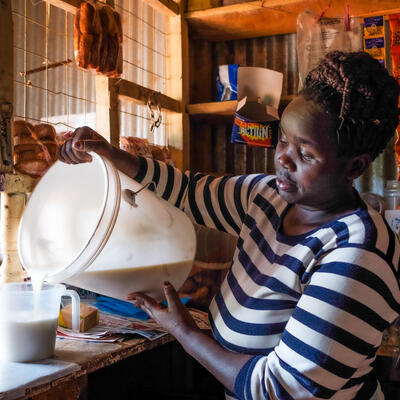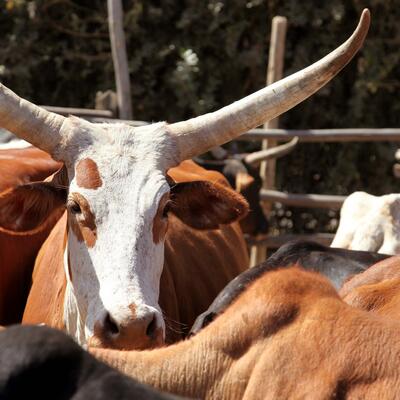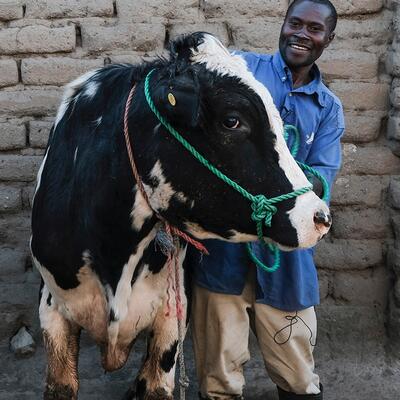
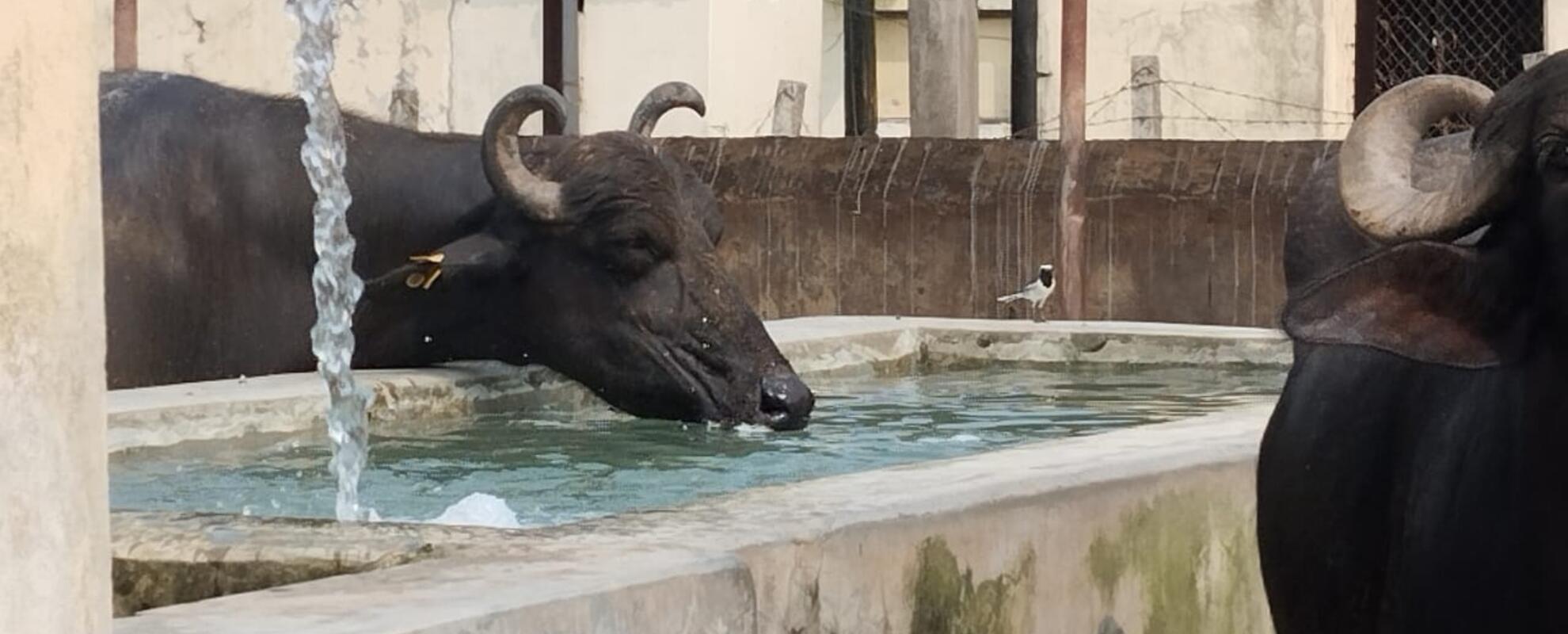
NEXUS Gains Initiative to develop strategy for efficient dairy production in water-stressed region of Nepal
ILRI News
Posted on
by
- Padmakumar Varijakshapanicker
- Bayissa Hatew
- Chris Jones
- Anil Aryal
- Santosh Nepal
- Matthew McCartney
Animal husbandry and dairy production are key sources of nutrition and livelihoods in Nepal. Out of the 3.8 million farming households in the country, 95% have dairy animals providing food, income and other benefits.
Livestock, especially dairy animals, contribute to household food security and nourishment of the most vulnerable, such as infants and pregnant/lactating women. Nevertheless, the per capita availability of milk in Nepal is around 159 grams per day (g/d), which is far below the 250 g/d recommended by the World Health Organization. Hence, the government is working towards increasing milk production and marketing to improve the livelihoods of farmers and household nutrition.
Water is critical in dairy farming, consisting of direct consumptive water and also so-called ‘virtual water’. The latter is the water required for the production of green fodder, dry fodder and concentrates. On average, a dairy animal producing 10 litres of milk per day requires 100 litres of drinking water daily. This is approximately 1% of the total water required for milk production, with the remaining 99% being virtual water. Studies in India showed that about 2,749 litres of water (both direct and virtual) are used to produce one litre of milk whereas the global average is 874 litres per litre of milk.
There is insufficient research in Nepal on water demand and use in animal husbandry in general, and specifically in dairy production, processing and loss reduction. In this context, the CGIAR-funded NEXUS Gains Initiative, through the International Livestock Research Institute (ILRI) is assessing the water use efficiency of dairy production in Madhesh Province, where ILRI is implementing its dairy value chain project called SAPLING (Sustainable Animal Productivity for Livelihoods, Income, Nutrition and Gender inclusion).
‘The initiative is expected to help develop a strategy to better utilize water for milk production, especially in the drought-prone areas of the country. This is crucial because dairy farming in Nepal is emerging as a commercial/semi-commercial enterprise, particularly within the semi-urban and all geographical regions,’ says Matthew McCartney, principal researcher at the International Water Management Institute (IWMI) and NEXUS Gains Initiative lead.
Competition for water between humans and livestock can increase when water becomes scarce in the dry season. This competition may result in livestock being watered inadequately, causing reduced feed intake and heat stress, thereby compromising productivity.
Water constitutes 56% (dry) to 81% (lactating) of a dairy cow’s liveweight, which is higher than other livestock. Dairy cows require water to maintain osmotic pressure in their cells and tissues, produce milk, eliminate waste materials and dissipate excess heat.

‘This pool of body water is maintained through direct intake (i.e. drinking) of water, in feed and water derived from metabolic oxidation. Efficiency of water intake for milk production is an important performance indicator, especially in tropical environments where heat stress may increase evaporative water loss,’ explains Bayissa Hatew, an ILRI scientist working on the initiative.
Increasing milk production in Nepal from 2 million tons in 2017 to a predicted 3 million tons in 2030 could lead to increased water depletion to the tune of 2.75 million m3. This poses a potential risk in the water-stressed and drought-prone regions of the country.
Though Nepal has abundant water for agriculture, some regions, mainly the Terai plains, are reported to be ‘water mines’. It is argued by some that if this region dries up, the country will be unliveable. Certain areas, such as Madhesh Province, are grappling with water crises. Traditional wells and shallow wells have dried up and sizeable tracts of cultivable land have been left barren by water shortages and reduced rainfall.
Farmers in Western Terai are also facing challenges in water productivity. They have complained that there is a reduction in livestock numbers due to labour shortages, agri-mechanization and closure of grazing land for community forestry. In August 2023, one of the political parties submitted a memorandum to Nepal’s prime minister, asking him to declare the Terai/Madhesh a drought hotspot and provide relief.
‘Water is insufficient in spring, not only because of low water flow during this season, but because of techno-institutional factors, such as poorly designed irrigation canals, issues related to irrigation scheduling between head and tail end users and inefficient water use practices,’ says Manohara Khadka, a scientist at IWMI.
Padmakumar Varijakshapanicker, the ILRI scientist leading this study on water use efficiency of dairy production, explains its objectives as follows:
- To assess the total quantity of water used per litre of milk production (m3/l).
This will be calculated by estimating drinking water (l), water present in feeds (fresh matter – dry matter) and embedded water used for producing green fodder, dry fodder and concentrate. The embedded water (l) will be calculated using variables such as harvest index, rainfall and transpiration. If irrigation is used to produce fodder, the quantity of irrigation water will be assessed by multiplying the number of irrigations with hours per irrigation and pump discharge (m3/hr). - To gain a comprehensive understanding of:
- the social and economic characteristics of dairy farmers;
- livestock ownership and composition;
- the availability, quality, utilization and management of feed resources;
- water use by dairy farmers; and
- insights related to the milk production practices, processes and outcomes.
This will be done through a survey and focus group discussions among 100 households situated in the drought-prone Pashupatinagar Village within Bardiwas Municipality of Mahottari District in Madhesh Province. Trained enumerators will conduct the survey under the guidance of a researcher. The data will be collected through structured questionnaires designed specifically for the survey.
- To determine the impact of two novel feed technologies (biofermentation and enriched shredded straw) on milk yield and water use efficiency.
This will be assessed through an on-station in vivo animal performance trial with lactating cows. The study hypothesis is that the feed technologies will increase both milk yield and water use efficiency in dairy production.
This study is scheduled to be completed by March 2024. The results will help to formulate policies and practices for efficient use of water for dairy production, especially in the water stressed regions in the country.
Acknowledgments:
ILRI acknowledges the financial support extended by International Water Management Institute through the CGIAR-funded NEXUS Gains Initiative.
You may also like
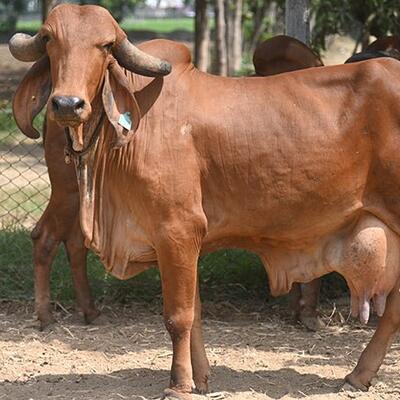
ILRI News
ILRI and India’s Ministry of Fisheries, Animal Husbandry and Dairying plan further collaboration
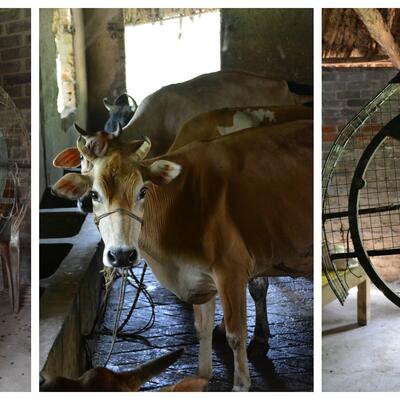
ILRI News
Kumaraguru Institutions and ILRI host forum on dairy landscape study of Tamil Nadu State, India
Related Publications

Dairy input agri-entrepreneurs’ practices and their effect on inputs market participation by smallholder farmers in Tanzania
- Kundu, R.N.
- Bett, H.K.
- Rao, E.J.O.

Antibiotic use on Kenya’s dairy farms is putting consumers and animals at risk
- Muloi, Dishon M.
- Moodley, Arshnee

Incentive-based capacity building to professionalize the informal sector: the MoreMilk project
- Alonso, Silvia
- Kibet, G.
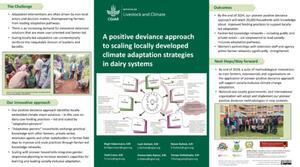
A positive deviance approach to scaling locally developed climate adaptation strategies in dairy systems
- Habermann, Birgit
- Crane, Todd A.
- Gichuki, Leah
- Kiptoo, Emmaculate
- Bullock, Renee
- DuttaGupta, Tanaya






